Abstract
OBJECTIVE--To examine the associations between physical activity and a wide range of risk factors for ischaemic heart disease including fibrinogen concentration and viscosity. DESIGN--Cross sectional evidence from the 2398 men aged 50-64 years in the Caerphilly Prospective Heart Disease Study. METHODS--Validated questionnaires were used to quantify energy expenditure on leisure activities and to grade activities related to occupation. Risk factors for heart disease examined included blood pressure, lipids, fibrinogen, and plasma viscosity. Possible confounding variables included smoking, employment, and prevalent heart disease (angina, previous myocardial infarction, and electrocardiographic evidence of ischaemia). RESULTS--Fibrinogen concentration was lower by 0.24 g/l and viscosity by 0.026 cP in the third of men who were most active in leisure activities (about 0.25 x 1 SD). A weak positive relation was found with high density lipoprotein cholesterol, but none with total cholesterol or fasting glucose concentrations or blood pressure. Triglyceride concentrations seem to be substantially lower in the most active men, although the evidence for this is not consistent. Work related activity showed relation with the lipid concentration but not with the haemostatic tests. CONCLUSIONS--Leisure activities of all levels seem to affect haemostatic and lipid factors beneficially. These effects correspond to a difference in the risk of heart disease for an active man and a sedentary man of at least 7% or 8%. Fasting triglyceride concentrations have already been shown to be strongly predictive of heart disease in this cohort of men, and the effect of exercise on this factor is also likely to confer benefit.
Full text
PDF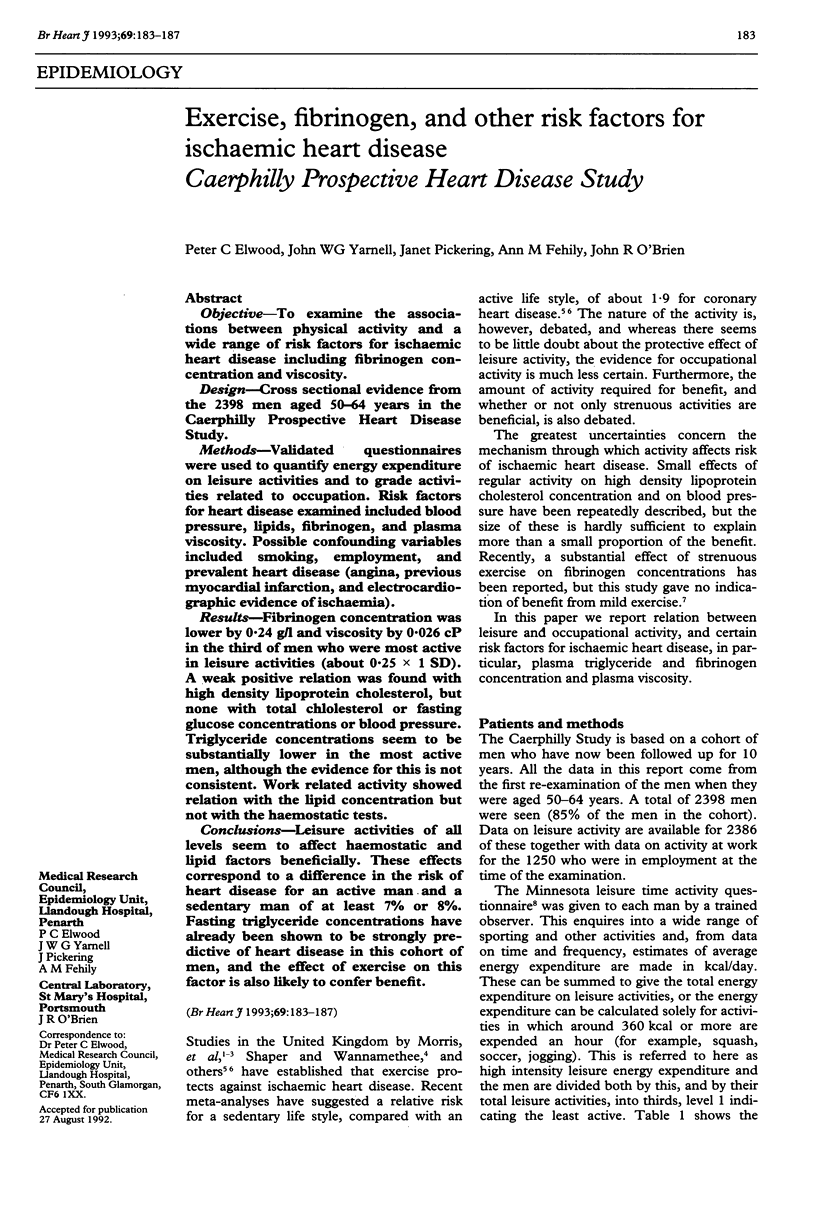
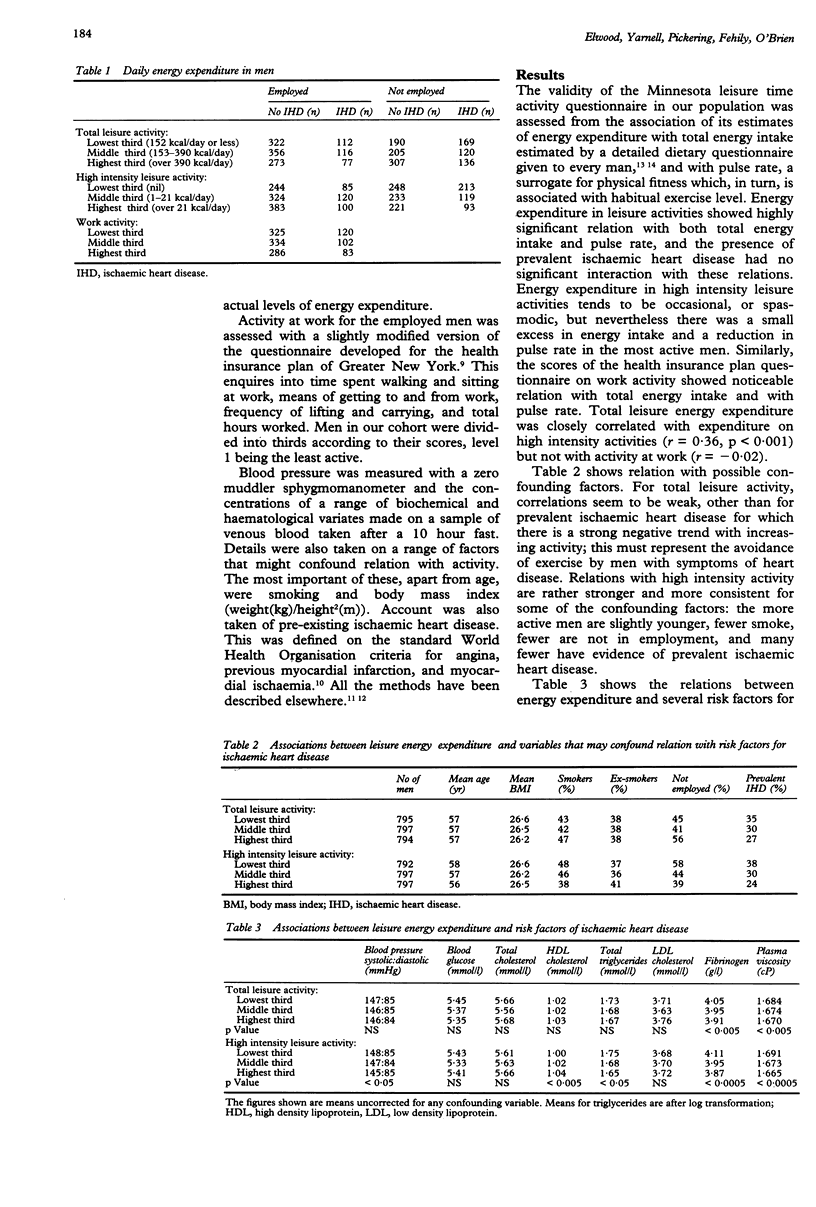
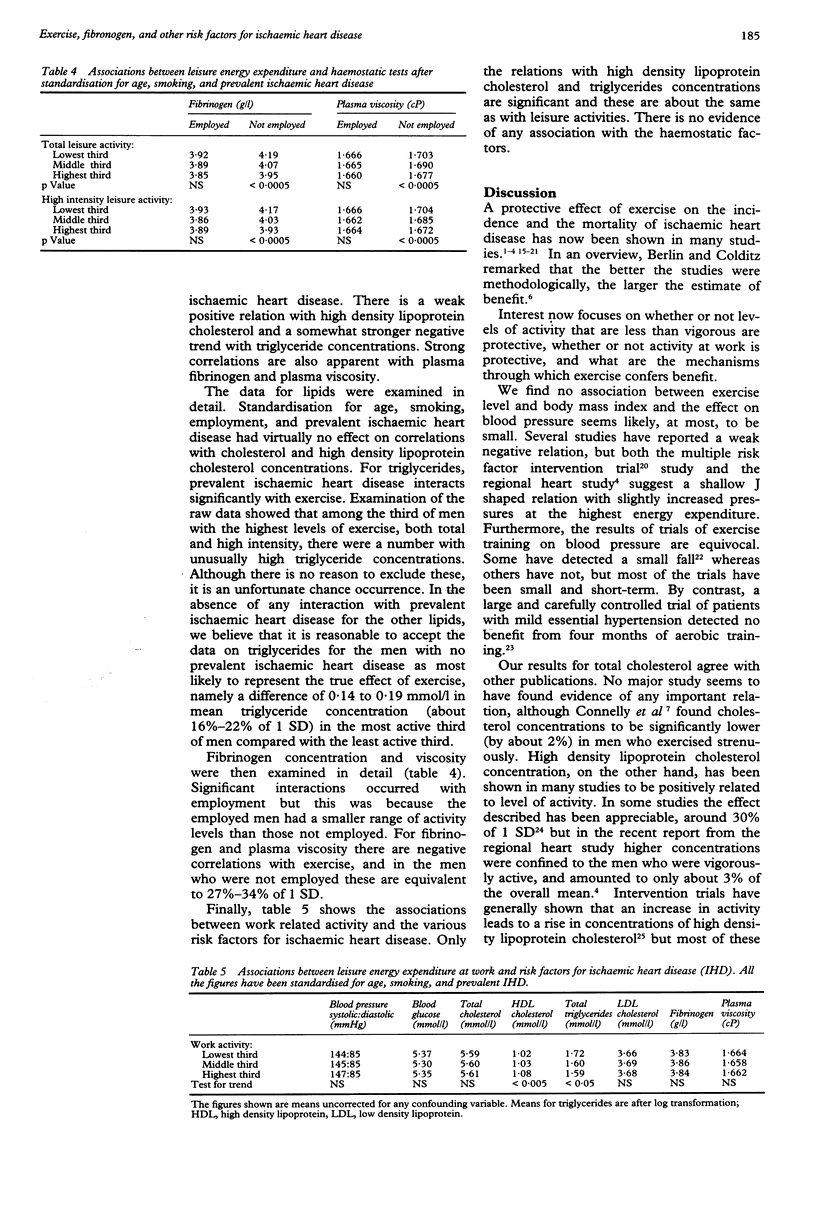
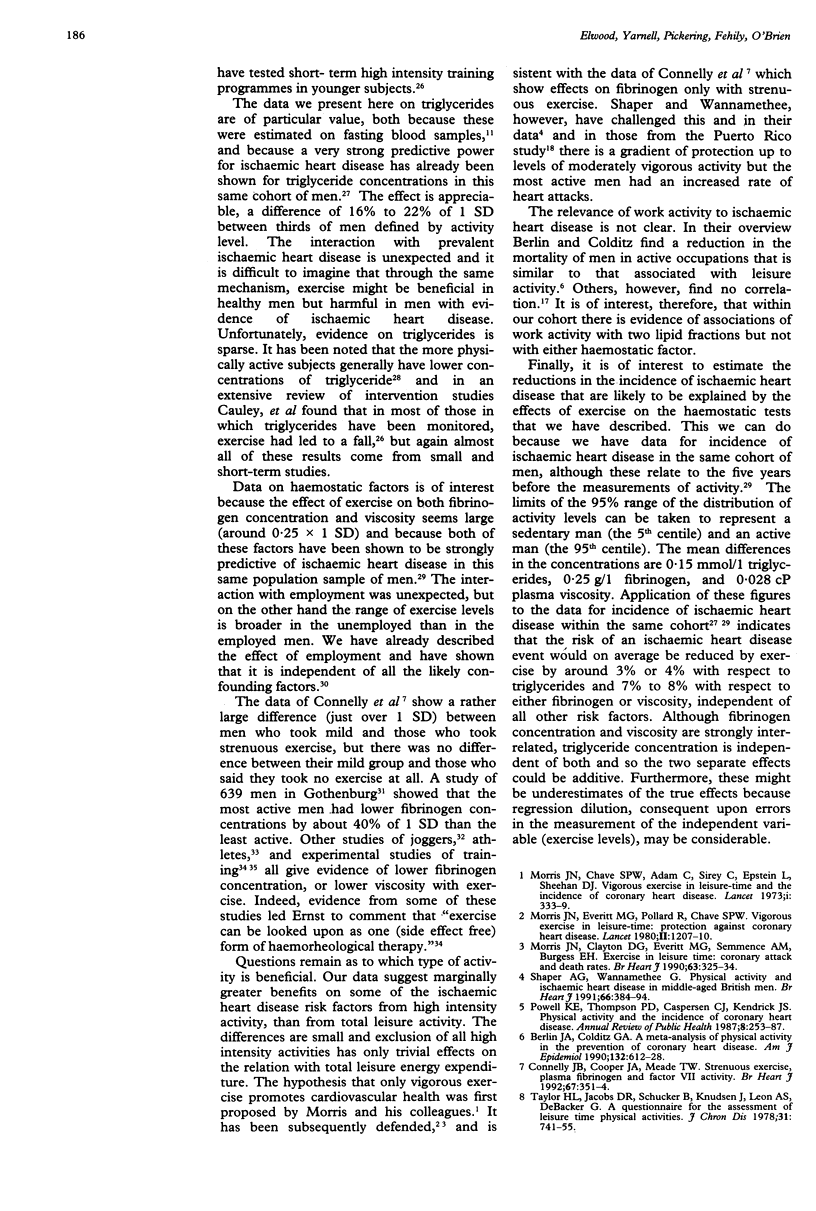
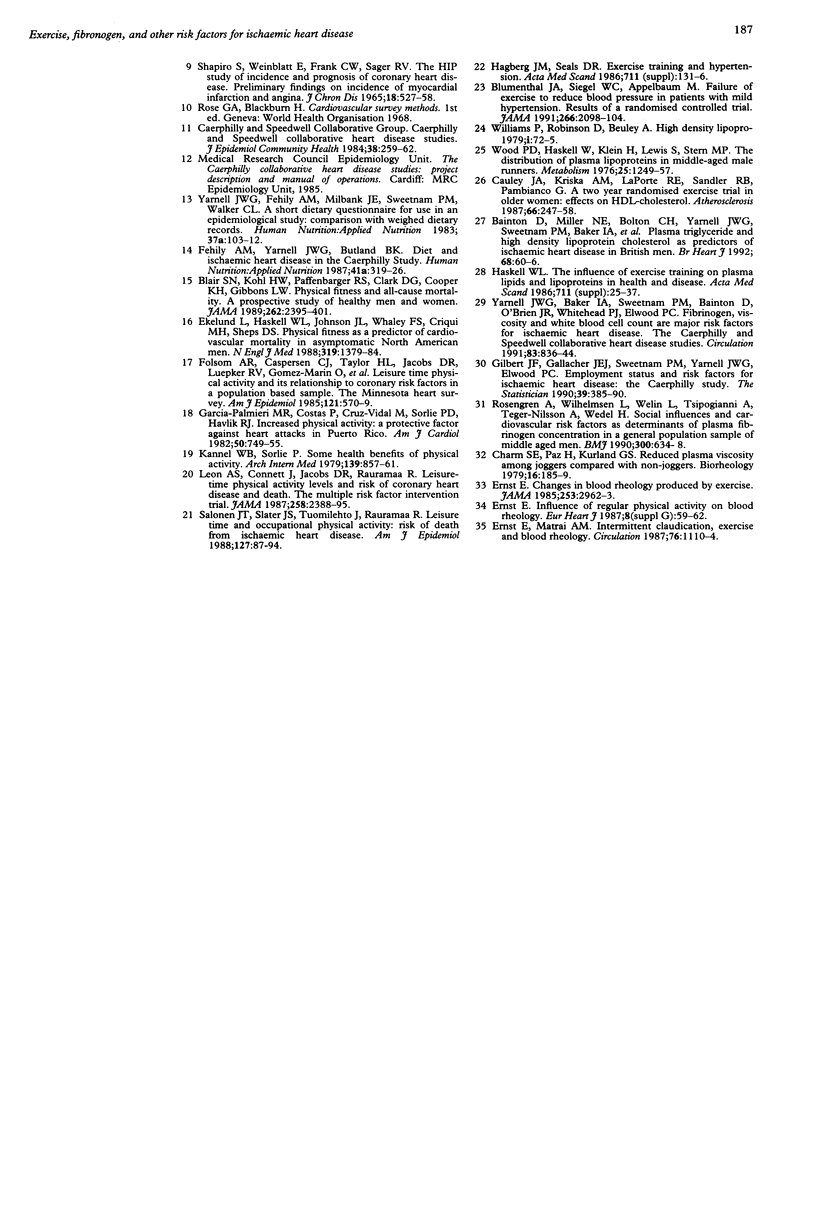
Selected References
These references are in PubMed. This may not be the complete list of references from this article.
- Bainton D., Miller N. E., Bolton C. H., Yarnell J. W., Sweetnam P. M., Baker I. A., Lewis B., Elwood P. C. Plasma triglyceride and high density lipoprotein cholesterol as predictors of ischaemic heart disease in British men. The Caerphilly and Speedwell Collaborative Heart Disease Studies. Br Heart J. 1992 Jul;68(1):60–66. doi: 10.1136/hrt.68.7.60. [DOI] [PMC free article] [PubMed] [Google Scholar]
- Berlin J. A., Colditz G. A. A meta-analysis of physical activity in the prevention of coronary heart disease. Am J Epidemiol. 1990 Oct;132(4):612–628. doi: 10.1093/oxfordjournals.aje.a115704. [DOI] [PubMed] [Google Scholar]
- Blair S. N., Kohl H. W., 3rd, Paffenbarger R. S., Jr, Clark D. G., Cooper K. H., Gibbons L. W. Physical fitness and all-cause mortality. A prospective study of healthy men and women. JAMA. 1989 Nov 3;262(17):2395–2401. doi: 10.1001/jama.262.17.2395. [DOI] [PubMed] [Google Scholar]
- Blumenthal J. A., Siegel W. C., Appelbaum M. Failure of exercise to reduce blood pressure in patients with mild hypertension. Results of a randomized controlled trial. JAMA. 1991 Oct 16;266(15):2098–2104. [PubMed] [Google Scholar]
- Cauley J. A., Kriska A. M., LaPorte R. E., Sandler R. B., Pambianco G. A two year randomized exercise trial in older women: effects on HDL-cholesterol. Atherosclerosis. 1987 Aug;66(3):247–258. doi: 10.1016/0021-9150(87)90068-2. [DOI] [PubMed] [Google Scholar]
- Charm S. E., Paz H., Kurland G. S. Reduced plasma viscosity among joggers compared with non-joggers. Biorheology. 1979;16(3):185–189. doi: 10.3233/bir-1979-16307. [DOI] [PubMed] [Google Scholar]
- Connelly J. B., Cooper J. A., Meade T. W. Strenuous exercise, plasma fibrinogen, and factor VII activity. Br Heart J. 1992 May;67(5):351–354. doi: 10.1136/hrt.67.5.351. [DOI] [PMC free article] [PubMed] [Google Scholar]
- Ekelund L. G., Haskell W. L., Johnson J. L., Whaley F. S., Criqui M. H., Sheps D. S. Physical fitness as a predictor of cardiovascular mortality in asymptomatic North American men. The Lipid Research Clinics Mortality Follow-up Study. N Engl J Med. 1988 Nov 24;319(21):1379–1384. doi: 10.1056/NEJM198811243192104. [DOI] [PubMed] [Google Scholar]
- Ernst E. E., Matrai A. Intermittent claudication, exercise, and blood rheology. Circulation. 1987 Nov;76(5):1110–1114. doi: 10.1161/01.cir.76.5.1110. [DOI] [PubMed] [Google Scholar]
- Ernst E. Changes in blood rheology produced by exercise. JAMA. 1985 May 24;253(20):2962–2963. [PubMed] [Google Scholar]
- Ernst E. Influence of regular physical activity on blood rheology. Eur Heart J. 1987 Oct;8 (Suppl G):59–62. doi: 10.1093/eurheartj/8.suppl_g.59. [DOI] [PubMed] [Google Scholar]
- Fehily A. M., Yarnell J. W., Butland B. K. Diet and ischaemic heart disease in the Caerphilly Study. Hum Nutr Appl Nutr. 1987 Oct;41(5):319–326. [PubMed] [Google Scholar]
- Folsom A. R., Caspersen C. J., Taylor H. L., Jacobs D. R., Jr, Luepker R. V., Gomez-Marin O., Gillum R. F., Blackburn H. Leisure time physical activity and its relationship to coronary risk factors in a population-based sample. The Minnesota Heart Survey. Am J Epidemiol. 1985 Apr;121(4):570–579. doi: 10.1093/oxfordjournals.aje.a114035. [DOI] [PubMed] [Google Scholar]
- Garcia-Palmieri M. R., Costas R., Jr, Cruz-Vidal M., Sorlie P. D., Havlik R. J. Increased physical activity: a protective factor against heart attacks in Puerto Rico. Am J Cardiol. 1982 Oct;50(4):749–755. doi: 10.1016/0002-9149(82)91229-2. [DOI] [PubMed] [Google Scholar]
- Hagberg J. M., Seals D. R. Exercise training and hypertension. Acta Med Scand Suppl. 1986;711:131–136. doi: 10.1111/j.0954-6820.1986.tb08941.x. [DOI] [PubMed] [Google Scholar]
- Haskell W. L. The influence of exercise training on plasma lipids and lipoproteins in health and disease. Acta Med Scand Suppl. 1986;711:25–37. doi: 10.1111/j.0954-6820.1986.tb08929.x. [DOI] [PubMed] [Google Scholar]
- Kannel W. B., Sorlie P. Some health benefits of physical activity. The Framingham Study. Arch Intern Med. 1979 Aug;139(8):857–861. [PubMed] [Google Scholar]
- Leon A. S., Connett J., Jacobs D. R., Jr, Rauramaa R. Leisure-time physical activity levels and risk of coronary heart disease and death. The Multiple Risk Factor Intervention Trial. JAMA. 1987 Nov 6;258(17):2388–2395. [PubMed] [Google Scholar]
- Morris J. N., Chave S. P., Adam C., Sirey C., Epstein L., Sheehan D. J. Vigorous exercise in leisure-time and the incidence of coronary heart-disease. Lancet. 1973 Feb 17;1(7799):333–339. doi: 10.1016/s0140-6736(73)90128-1. [DOI] [PubMed] [Google Scholar]
- Morris J. N., Clayton D. G., Everitt M. G., Semmence A. M., Burgess E. H. Exercise in leisure time: coronary attack and death rates. Br Heart J. 1990 Jun;63(6):325–334. doi: 10.1136/hrt.63.6.325. [DOI] [PMC free article] [PubMed] [Google Scholar]
- Morris J. N., Everitt M. G., Pollard R., Chave S. P., Semmence A. M. Vigorous exercise in leisure-time: protection against coronary heart disease. Lancet. 1980 Dec 6;2(8206):1207–1210. doi: 10.1016/s0140-6736(80)92476-9. [DOI] [PubMed] [Google Scholar]
- Powell K. E., Thompson P. D., Caspersen C. J., Kendrick J. S. Physical activity and the incidence of coronary heart disease. Annu Rev Public Health. 1987;8:253–287. doi: 10.1146/annurev.pu.08.050187.001345. [DOI] [PubMed] [Google Scholar]
- Rosengren A., Wilhelmsen L., Welin L., Tsipogianni A., Teger-Nilsson A. C., Wedel H. Social influences and cardiovascular risk factors as determinants of plasma fibrinogen concentration in a general population sample of middle aged men. BMJ. 1990 Mar 10;300(6725):634–638. doi: 10.1136/bmj.300.6725.634. [DOI] [PMC free article] [PubMed] [Google Scholar]
- SHAPIRO S., WEINBLATT E., FRANK C. W., SAGER R. V. THE H.I.P. STUDY OF INCIDENCE AND PROGNOSIS OF CORONARY HEART DISEASE; PRELIMINARY FINDINGS ON INCIDENCE OF MYOCARDIAL INFARCTION AND ANGINA. J Chronic Dis. 1965 Jun;18:527–558. [PubMed] [Google Scholar]
- Salonen J. T., Slater J. S., Tuomilehto J., Rauramaa R. Leisure time and occupational physical activity: risk of death from ischemic heart disease. Am J Epidemiol. 1988 Jan;127(1):87–94. doi: 10.1093/oxfordjournals.aje.a114794. [DOI] [PubMed] [Google Scholar]
- Shaper A. G., Wannamethee G., Weatherall R. Physical activity and ischaemic heart disease in middle-aged British men. Br Heart J. 1991 Nov;66(5):384–394. doi: 10.1136/hrt.66.5.384. [DOI] [PMC free article] [PubMed] [Google Scholar]
- Taylor H. L., Jacobs D. R., Jr, Schucker B., Knudsen J., Leon A. S., Debacker G. A questionnaire for the assessment of leisure time physical activities. J Chronic Dis. 1978;31(12):741–755. doi: 10.1016/0021-9681(78)90058-9. [DOI] [PubMed] [Google Scholar]
- Wood P. D., Haskell W., Klein H., Lewis S., Stern M. P., Farquhar J. W. The distribution of plasma lipoproteins in middle-aged male runners. Metabolism. 1976 Nov;25(11):1249–1257. doi: 10.1016/s0026-0495(76)80008-x. [DOI] [PubMed] [Google Scholar]
- Yarnell J. W., Fehily A. M., Milbank J. E., Sweetnam P. M., Walker C. L. A short dietary questionnaire for use in an epidemiological survey: comparison with weighed dietary records. Hum Nutr Appl Nutr. 1983 Apr;37(2):103–112. [PubMed] [Google Scholar]


